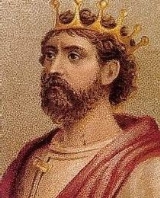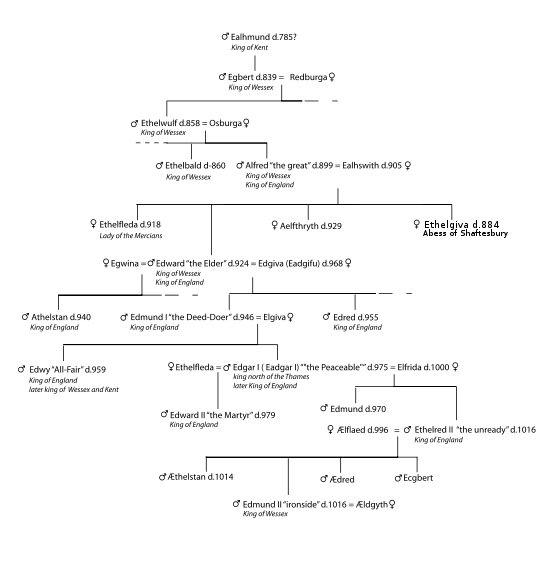
Edmund I of England
Encyclopedia
Edmund I (922 – 26 May 946), called the Elder, the Deed-doer, the Just, or the Magnificent, was King of England from 939 until his death. He was a son of Edward the Elder
and half-brother of Athelstan
. Athelstan died on 27 October 939, and Edmund succeeded him as king.
conquered Northumbria
and invaded the Midlands
. When Olaf died in 942 Edmund reconquered the Midlands. In 943 he became the god-father of King Olaf of York. In 944, Edmund was successful in reconquering Northumbria. In the same year his ally Olaf of York lost his throne and left for Dublin in Ireland. Olaf became the king of Dublin as Olaf Cuaran
and continued to be allied to his god-father. In 945 Edmund conquered Strathclyde
but ceded the territory to King Malcolm I of Scotland
in exchange for a treaty of mutual military support. Edmund thus established a policy of safe borders and peaceful relationships with Scotland
. During his reign, the revival of monasteries
in England began.
to the throne. Louis, son of Charles the Simple
and Edmund's half-sister Eadgifu
, had resided at the West-Saxon court for some time until 936, when he returned to be crowned King of France. In the summer of 945, he was captured by the Norsemen of Rouen and subsequently released to Duke Hugh the Great
, who held him in custody. The chronicler Richerus
claims that Eadgifu wrote letters both to Edmund and to Otto I in which she requested support for her son. Edmund responded to her plea by sending angry threats to Hugh, who brushed them aside. Flodoard
's Annales, one of Richerus' sources, report:
(South Gloucestershire). John of Worcester
and William of Malmesbury
add some lively detail by suggesting that Edmund had been feasting with his nobles, when he spotted Leofa in the crowd. He attacked the intruder in person, but in the event, Edmund and Leofa were both killed.
Edmund's sister Eadgyth
, wife to Otto I
, died (earlier) the same year, as Flodoard
's Annales for 946 report.
Edmund was succeeded as king by his brother Edred
, king from 946 until 955. Edmund's sons later ruled England as:

Edward the Elder
Edward the Elder was an English king. He became king in 899 upon the death of his father, Alfred the Great. His court was at Winchester, previously the capital of Wessex...
and half-brother of Athelstan
Athelstan of England
Athelstan , called the Glorious, was the King of England from 924 or 925 to 939. He was the son of King Edward the Elder, grandson of Alfred the Great and nephew of Æthelflæd of Mercia...
. Athelstan died on 27 October 939, and Edmund succeeded him as king.
Military threats
Shortly after his proclamation as king he had to face several military threats. King Olaf III GuthfrithsonOlaf III Guthfrithson
Amlaíb mac Gofraid , a member of the Norse-Gael Uí Ímair dynasty, was King of Dublin from 934 to 941...
conquered Northumbria
Northumbria
Northumbria was a medieval kingdom of the Angles, in what is now Northern England and South-East Scotland, becoming subsequently an earldom in a united Anglo-Saxon kingdom of England. The name reflects the approximate southern limit to the kingdom's territory, the Humber Estuary.Northumbria was...
and invaded the Midlands
English Midlands
The Midlands, or the English Midlands, is the traditional name for the area comprising central England that broadly corresponds to the early medieval Kingdom of Mercia. It borders Southern England, Northern England, East Anglia and Wales. Its largest city is Birmingham, and it was an important...
. When Olaf died in 942 Edmund reconquered the Midlands. In 943 he became the god-father of King Olaf of York. In 944, Edmund was successful in reconquering Northumbria. In the same year his ally Olaf of York lost his throne and left for Dublin in Ireland. Olaf became the king of Dublin as Olaf Cuaran
Olaf Cuaran
Amlaíb mac Sitric , commonly called Amlaíb Cuarán, in Old Norse: Óláfr kváran, was a 10th century Norse-Gael who was king of Northumbria and king of Dublin. His byname, cuarán, is usually translated as "sandal"...
and continued to be allied to his god-father. In 945 Edmund conquered Strathclyde
Kingdom of Strathclyde
Strathclyde , originally Brythonic Ystrad Clud, was one of the early medieval kingdoms of the celtic people called the Britons in the Hen Ogledd, the Brythonic-speaking parts of what is now southern Scotland and northern England. The kingdom developed during the post-Roman period...
but ceded the territory to King Malcolm I of Scotland
Malcolm I of Scotland
Máel Coluim mac Domnaill was king of Scots , becoming king when his cousin Causantín mac Áeda abdicated to become a monk...
in exchange for a treaty of mutual military support. Edmund thus established a policy of safe borders and peaceful relationships with Scotland
Scotland
Scotland is a country that is part of the United Kingdom. Occupying the northern third of the island of Great Britain, it shares a border with England to the south and is bounded by the North Sea to the east, the Atlantic Ocean to the north and west, and the North Channel and Irish Sea to the...
. During his reign, the revival of monasteries
Monastery
Monastery denotes the building, or complex of buildings, that houses a room reserved for prayer as well as the domestic quarters and workplace of monastics, whether monks or nuns, and whether living in community or alone .Monasteries may vary greatly in size – a small dwelling accommodating only...
in England began.
Louis IV of France
One of Edmund's last political movements of which we have some knowledge is his role in the restoration of Louis IV of FranceLouis IV of France
Louis IV , called d'Outremer or Transmarinus , reigned as King of Western Francia from 936 to 954...
to the throne. Louis, son of Charles the Simple
Charles the Simple
Charles III , called the Simple or the Straightforward , was the undisputed King of France from 898 until 922 and the King of Lotharingia from 911 until 919/23...
and Edmund's half-sister Eadgifu
Eadgifu of England
Eadgifu or Edgifu, also known as Edgiva or Ogive was a daughter of Edward the Elder, King of Wessex and England, and his second wife Ælfflæd. She was born in Wessex.- Marriage to the French King :...
, had resided at the West-Saxon court for some time until 936, when he returned to be crowned King of France. In the summer of 945, he was captured by the Norsemen of Rouen and subsequently released to Duke Hugh the Great
Hugh the Great
Hugh the Great or Hugues le Grand was duke of the Franks and count of Paris, son of King Robert I of France and nephew of King Odo. He was born in Paris, Île-de-France, France. His eldest son was Hugh Capet who became King of France in 987...
, who held him in custody. The chronicler Richerus
Richerus
Richer was a monk of St.-Remigius, just outside Reims, and a chronicler of the 10th century. He is not to be confused with Richer le Lorrain or Richer de Senones .-Life:...
claims that Eadgifu wrote letters both to Edmund and to Otto I in which she requested support for her son. Edmund responded to her plea by sending angry threats to Hugh, who brushed them aside. Flodoard
Flodoard
-Biography:He was born at Épernay, and educated at Reims in the cathedral school which had been established by Archbishop Fulcon .As canon of Reims, and favourite of the archbishops Herivaeus and Seulfus -Biography:He was born at Épernay, and educated at Reims in the cathedral school which had...
's Annales, one of Richerus' sources, report:
Death and succession
On 26 May 946, Edmund was murdered by Leofa, an exiled thief, while celebrating St Augustine's Mass Day in PucklechurchPucklechurch
Pucklechurch is a village in South Gloucestershire, England, United Kingdom.- Location :Pucklechurch is a historic village with an incredibly rich past, from the Bronze Age with its tumulus on Shortwood Hill, up to the siting of a barrage balloon depot in World War II...
(South Gloucestershire). John of Worcester
John of Worcester
John of Worcester was an English monk and chronicler. He is usually held to be the author of the Chronicon ex chronicis.-Chronicon ex chronicis:...
and William of Malmesbury
William of Malmesbury
William of Malmesbury was the foremost English historian of the 12th century. C. Warren Hollister so ranks him among the most talented generation of writers of history since Bede, "a gifted historical scholar and an omnivorous reader, impressively well versed in the literature of classical,...
add some lively detail by suggesting that Edmund had been feasting with his nobles, when he spotted Leofa in the crowd. He attacked the intruder in person, but in the event, Edmund and Leofa were both killed.
Edmund's sister Eadgyth
Eadgyth
Edith of England , also spelt Eadgyth or Ædgyth, was the daughter of Edward the Elder, and the wife of Otto I, Holy Roman Emperor.-Life:...
, wife to Otto I
Otto I, Holy Roman Emperor
Otto I the Great , son of Henry I the Fowler and Matilda of Ringelheim, was Duke of Saxony, King of Germany, King of Italy, and "the first of the Germans to be called the emperor of Italy" according to Arnulf of Milan...
, died (earlier) the same year, as Flodoard
Flodoard
-Biography:He was born at Épernay, and educated at Reims in the cathedral school which had been established by Archbishop Fulcon .As canon of Reims, and favourite of the archbishops Herivaeus and Seulfus -Biography:He was born at Épernay, and educated at Reims in the cathedral school which had...
's Annales for 946 report.
Edmund was succeeded as king by his brother Edred
Edred of England
Eadred was the king of England from 946 until his death in 955, in succession to his elder brother Edmund I.-Background and succession:...
, king from 946 until 955. Edmund's sons later ruled England as:
- Eadwig of England, King from 955 until 957, king of only WessexWessexThe Kingdom of Wessex or Kingdom of the West Saxons was an Anglo-Saxon kingdom of the West Saxons, in South West England, from the 6th century, until the emergence of a united English state in the 10th century, under the Wessex dynasty. It was to be an earldom after Canute the Great's conquest...
and Kingdom of KentKingdom of KentThe Kingdom of Kent was a Jutish colony and later independent kingdom in what is now south east England. It was founded at an unknown date in the 5th century by Jutes, members of a Germanic people from continental Europe, some of whom settled in Britain after the withdrawal of the Romans...
from 957 until his death on 1 October 959. - Edgar of EnglandEdgar of EnglandEdgar the Peaceful, or Edgar I , also called the Peaceable, was a king of England . Edgar was the younger son of Edmund I of England.-Accession:...
, king of only MerciaMerciaMercia was one of the kingdoms of the Anglo-Saxon Heptarchy. It was centred on the valley of the River Trent and its tributaries in the region now known as the English Midlands...
and NorthumbriaNorthumbriaNorthumbria was a medieval kingdom of the Angles, in what is now Northern England and South-East Scotland, becoming subsequently an earldom in a united Anglo-Saxon kingdom of England. The name reflects the approximate southern limit to the kingdom's territory, the Humber Estuary.Northumbria was...
from 957 until his brother's death in 959, then king of England from 959 until 975.
Ancestry


